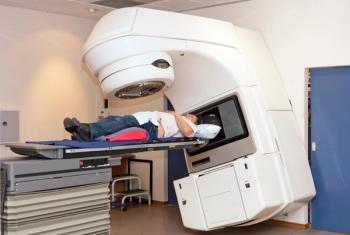
Stereotactic body radiotherapy may be superior to conventional palliative radiotherapy in improving the complete response rate for pain related to spinal metastases at 3- and 6-months post-radiation.

Your AI-Trained Oncology Knowledge Connection!


Stereotactic body radiotherapy may be superior to conventional palliative radiotherapy in improving the complete response rate for pain related to spinal metastases at 3- and 6-months post-radiation.

When compared with whole brain radiation therapy, researchers discovered highly focused radiation therapy led to less cognitive decline while simultaneously delivering equivalent overall survival rates.

Venetoclax was granted approval in combination with azacitidine, decitabine, or low dose cytarabine earlier this month for adults 75 years or older with newly diagnosed acute myeloid leukemia or those who have comorbidities precluding intensive induction chemotherapy.

The updated guidelines outlined indications and best practices for pelvic radiation treatments, as well as the integration of radiation with chemotherapy and surgery for patients with stage II to III disease.

This study found that the impact of COVID-19 on cancer care in the US has led to decreases and delays in identifying new cancers, as well as the delivery of treatment.

The FDA approved expanded claims for the cobas EGFR Mutation Test v2 as a companion diagnostic for a broader group of therapies in the treatment of non-small cell lung cancer.

Patients who participated in the Beat AML Master clinical trial were found to have superior outcomes with precision medicine, compared to patients with acute myeloid leukemia who opted for standard chemotherapy treatment.

“Our findings suggest that distinct genetic alterations in the prostate cancers of African American men, in comparison to white men, may contribute to more aggressive prostate cancer and could lead to a higher mortality rate,” said study senior author Jianfeng Xu, DrPH.

The FDA granted priority review to the supplemental biologics license application for cemiplimab-rwlc (Libtayo) as a first-line treatment for patients with locally advanced or metastatic non-small cell lung cancer with 50% or more PD-L1 expression.

CancerNetwork® will be hosting a tweet chat that will feature mock tumor board on prostate cancer this Friday, October 30th, at 12 PM EST.

According to researchers, these findings “support the hypothesis that regional nodal disease may precede and contribute to the seeding of distant foci.”

For the first time, the draft recommendations from the US Preventive Services Task Force indicate that screening for colorectal cancer begin at age 45.

The FDA granted priority review to the supplemental biologics license application for trastuzumab deruxtecan (Enhertu) for the treatment of patients with HER2-positive metastatic gastric or gastroesophageal junction adenocarcinoma.

In June 2020, the FDA approved tazemetostat (Tazverik) for 2 distinct follicular lymphoma indications based on overall response rate and duration of response observed in phase 2 clinical trial cohorts of patients with follicular lymphoma with EZH2 mutations and wild-type EZH2.

“This algorithm could allow us a better shot at personalized medicine and enhance our ability to tailor the treatments to be as appropriate as possible,” said study author Daniel Chang, MD.

The FDA approved the FoundationOne Liquid CDx for 3 new companion diagnostic indications to help match patients who could benefit from treatment with specific FDA-approved targeted therapies.

According to this study, patients with locoregionally advanced head and neck cancer with a higher risk of cancer progression relative to competing mortality, defined by a higher ω score, selectively benefit from more intensive treatment.

“This study for the first time systematically examined the risks of injuries during the cervical diagnostic workup,” said corresponding author Qing Shen, PhD.

Researchers indicated these findings provide evidence of the importance of increased moderate to vigorous physical activity and decreased sitting for improved health in older adults with or without a prior cancer diagnosis.

The expert in breast imaging spoke about the latest in breast imaging and the new technologies that are helping to advance the field.

The FoundationOne CDx is now approved by the FDA as a companion diagnostic for larotrectinib (Vitrakvi) to identify patients with NTRK fusions across all solid tumors.

A study which evaluated lapatinib (Tykerb) and trastuzumab (Herceptin) given prior to surgery in patients with early HER2-positive breast cancer revealed that women who had a pathological complete response survived longer without the cancer returning than those who did not.

Combination treatment with tremelimumab and durvalumab was found to be well-tolerated and showed early signs of activity in certain patients with localized bladder cancer who are not eligible for cisplatin-based chemotherapy.

Black race was associated with improved prostate cancer-specific mortality and all-cause mortality among men with nonmetastatic prostate cancer who received radiation therapy in this large equal-access health care system.

Researchers indicated that these findings demonstrate a need for interventions to improve prognostic understanding between older patients with advanced cancer, caregivers, and health care professionals.

The expert in breast imaging spoke about the use of the technology, and why it is more effective than traditional mammograms.

According to researchers, this study suggests “that the improvements in QOL and mood experienced by caregivers assigned to BMT-CARE are, in part, explained by an acquisition of effective coping skills and confidence in their ability to provide care for their loved one.”

However, though the CD56 target was confirmed to be expressed in the tumor types studied, the clinical efficacy of lorvotuzumab mertansine was limited.

An intervention that delivered machine learning mortality predictions with behavioral nudges to oncology clinicians significantly increased the rate of serious illness conversations among all patients included in this study.

Researchers demonstrated for the first time that radiation remodels T-cell responses found within the tumors of patients with renal cell carcinoma.